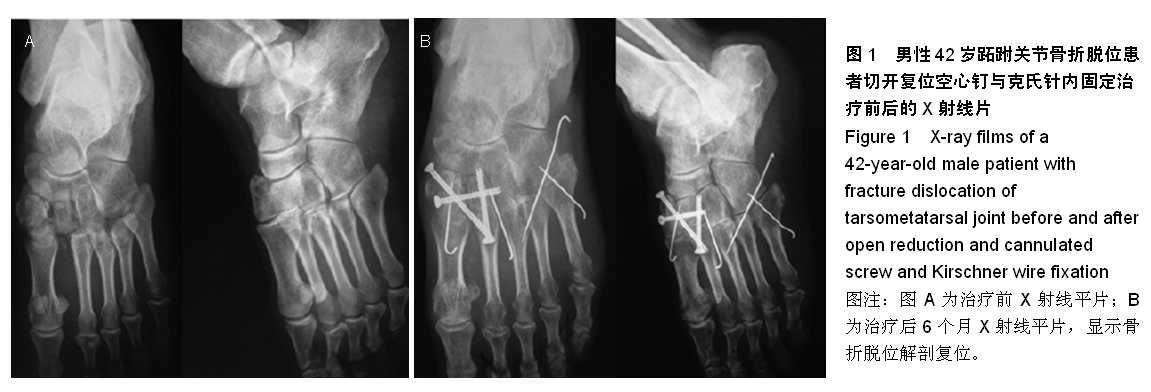| [1] 郭洪亮,韩亚军,伊力哈木•托合提,等.Lisfranc损伤术后创伤性关节炎的临床研究[J].中国医学创新,2014,11(24):34-37.
[2] 秦佳军,蔡贤华,魏世隽,等.4.0mm空心螺钉与克氏针内固定联合足弓支撑垫治疗Lisfranc损伤[J].生物骨科材料与临床研究, 2015, 12(1):33-35.
[3] 喻鑫罡,施忠民,陈旸,等.中足三柱理论在跖跗关节损伤治疗中的临床应用[J].中华创伤骨科杂志,2010,12(5):413-416.
[4] 周华,陈刚,李立,等.跖跗关节脱位或骨折脱位的治疗(附18例分析)[J].航空航天医学杂志,2012,23(3):335-336.
[5] 安建立,舒衡生,王宏川,等.切开复位双重加压螺钉固定治疗跖跗关节损伤[J].中国矫形外科杂志,2012,20(10):871-873,892.
[6] 谭鹏.探讨切开复位双重加压螺钉固定治疗跖跗关节损伤的临床疗效[J].医学信息,2014,27(17):476-477.
[7] 胡其恭,马琳,刘国江,等.探讨切开复位双重加压螺钉固定治疗跖跗关节损伤的临床疗效[J].中国社区医师,2014,30(8): 36,38.
[8] 陈艳红.跖跗关节损伤采用切开复位双重加压螺钉固定治疗的临床体会[J].中国保健营养(下旬刊),2014,25(5):2607-2608.
[9] 贾少华,徐红伟,何晓君,等.应用中足三柱理论治疗跖跗关节损伤[J].浙江创伤外科,2013,18(4):493-494.
[10] Myerson MS.The diagnosis and treatment of injury to the tarsometa?tarsal joint complex. J Bone Joint Surg(Br). 1999; 81(5):756-763.
[11] 张建北,刘伟峰,王俊,等.手术治疗跖跗关节损伤22例分析[J].中国煤炭工业医学杂志,2011,14(8):1170-1171.
[12] 袁维,陈云丰.严重跖跗关节骨折脱位的治疗[J].实用骨科杂志, 2008,14(12):728-730.
[13] Ulbrich EJ, Zubler V, Sutter R. Ligaments of the Lisfranc joint in MRI: 3D-SPACE (sampling perfection with application optimized contrasts using different flip-angle evolution) sequence compared to three orthogonal proton-density fat-saturated (PD fs) sequences.Skeletal Radiol. 2013;42 (3):399-409.
[14] 何小文,黄涛,刘成文,等.跖跗关节骨折脱位的诊治体会[J].中国骨与关节损伤杂志,2008,23(8):697-698.
[15] 施忠民,顾文奇,张长青,等.跖跗关节复合体损伤的手术治疗[J].中华外科杂志,2010,48(9):651-654.
[16] 侯彦杰,闫斌,韩亚军,等.金属植入物内固定修复跖跗关节损伤:18例生物力学评价[J].中国组织工程研究,2014,18(35): 5693-5698.
[17] 刘洪达,曲家富,李绍光,等.一期解剖复位内固定结合负压封闭引流技术治疗开放性跖跗关节骨折脱位[J].中国骨与关节损伤杂志, 2010,25(12):1083-1085.
[18] 张海波,李华强,王晓,等.新鲜高能量跖跗关节骨折脱位的临床特点及治疗策略[J].中国矫形外科杂志,2009,17(24):1841-1843.
[19] 王天旭,李兴华.微型钢板内固定术治疗跖跗关节骨折脱位临床观察[J].山东医药,2009,49(6):79-80.
[20] 姚琦,陈迎春,张亘瑷,等.空心螺钉三柱重建技术治疗Lisfranc关节损伤[J].中华创伤杂志,2011,27(10):893-896.
[21] Lewis C, Mauffrey C, Dickenson E. Open reduction and internal fixation compared with primary arthrodesis of Lisfranc injuries: a systematic review of the literature. Curr Orthop Prac. 2012;23(6):595-600.
[22] 张龙君,陈建良,郑晓东,等.切开复位内固定治疗跖跗关节损伤伴跖骨骨折[J].中国骨伤,2010,23(5):390-392.
[23] 梅晓龙.中足三柱重建技术治疗跖跗关节复合体损伤[C].//第二十届全国中西医结合骨伤科学术研讨会、第二届中国医师协会中西医结合医师分会骨伤科学术年会、第十九届浙江省中西医结合骨伤科专业委员会学术年会论文集.2013:100-102.
[24] 祝继明,郭亮.空心钉结合克氏针治疗跖跗关节骨折脱位[J].中国中西医结合外科杂志,2014,20(1):74-75.
[25] Pereira CJ, Espinosa EG, Miranda I, et al. Evaluation of the surgical treatment of Lisfranc joint fracture-dislocation. Acta Ortop Bras. 2008;16:93-97.
[26] 倪喆,夏天,杨述华,等.不同方法治疗跖跗关节损伤疗效分析[J].临床骨科杂志,2012,15(1):67-69.
[27] 宋谋珂,夏天,叶哲伟,等.跖跗关节复合体损伤的诊断与治疗方案的选择[J].中国骨与关节杂志,2013,12(7):382-385.
[28] Boffeli TJ, Pfannenstein RR, Thompson JC. Combined Medial Column Primary Arthrodesis, Middle Column Open Reduction Internal Fixation, and Lateral Column Pinning for Treatment of Lisfranc Fracture-Dislocation Injuries. J Foot Ankle Surg. 2014.
[29] 黄杰烽,郑杨,陈星,等.伴第2跖骨基底部粉碎的Lisfranc损伤的手术治疗[J].中国骨伤,2015,28(2):171-173.
[30] Cook KD, Jeffries LC, O'Connor JP. Determining the Strongest Orientation for “Lisfranc's Screw” in Transverse Plane Tarsometatarsal Injuries: A Cadaveric Study.J Foot Ankle Surg. 2009;48 (4):427-431.
[31] 熊家伟,刘国辉,杨述华,等.空心加压螺钉联合克氏针治疗跖跗关节骨折脱位[J].临床骨科杂志,2011,14(3):319-321.
[32] 谢跃德,谢艺君,李建昌,等.跖跗关节骨折脱位的诊治体会[J].中国骨与关节损伤杂志,2012,27(12):1138-1139.
[33] 熊力伟.手术治疗闭合性跖跗关节骨折脱位12例疗效分析[J].中外健康文摘,2013,10(31):153.
[34] 芦克洲,王冰,周金贤,等.切开复位内固定治疗跖跗关节骨折脱位[J].临床骨科杂志,2014,17(2):186-186,190.
[35] 张玉新,王淑丽,马信龙,等.隐匿性足Lisfranc损伤的临床特征及多层CT表现[J].中国临床医学影像杂志,2013,24(3):188-191.
[36] 徐海斌.闭合手法与手术开放整复跖跗关节骨折脱位的临床分析[J].中国伤残医学,2014,22(18):57-58.
[37] 陈建良,张龙君,叶锋,等.跖跗关节复合体损伤的诊治探讨[J].中国骨伤,2011,24(10):869-872.
[38] 来进杰,陈高新,金登峰,等.跖跗关节脱位伴骨折的手术治疗[J].中医正骨,2010,22(10):58-58.
[39] 赵宏,方煜,李纯志,等.可吸收钉经皮克氏针固定治疗跖跗关节骨折脱位[J].实用骨科杂志,2010,16(5):394-395.
[40] 王巍,何飞熊,叶舟,等.开放复位内固定治疗跖跗关节损伤19例[J].中医正骨,2011,23(1):52-53. |
